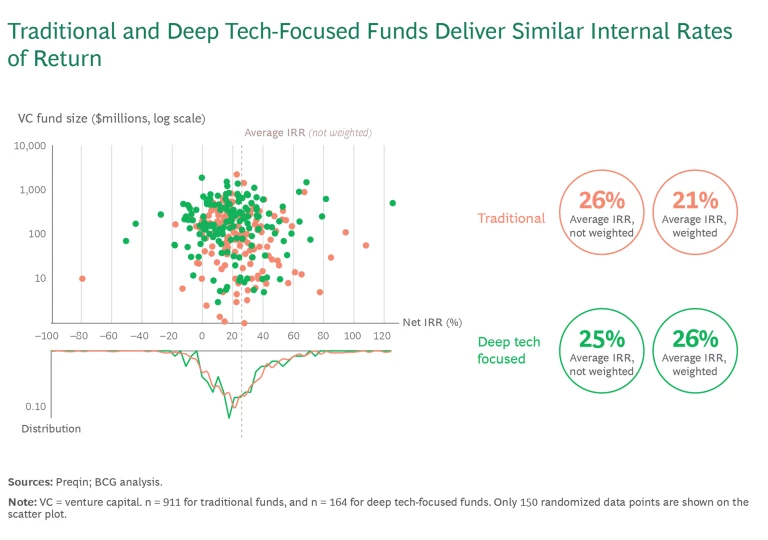Here are two facts that may surprise many investors. The first is that deep (or emerging) technologies have become a mainstream destination for corporate, venture capital, sovereign wealth, and private equity funds. Deep tech claims a stable 20% share of venture capital funding, up from about 10% a decade ago. Second, deep tech returns are similar to those of other venture investments. (See the exhibit.) Our analysis of about 1,100 venture funds shows that over the past five years, the weighted average internal rate of return was 21% for traditional venture capital investors and 26% for deep tech-focused funds. (The nonweighted returns were 26% and 25%, respectively.)

Forward-looking investors understand that deep tech offers attractive rewards because its companies tackle large problems. Startups seek to make big societal, technological, or economic impacts that unlock hefty markets in fields such as climate change, food shortages, and disease. Investors are making bigger bets. The size of the average deep tech investment has significantly increased in recent years, with many investments now reaching $100 million or more. Billion-dollar funding commitments are no longer uncommon.
Deep tech companies and their investors still face plenty of challenges. Scientific, technological, and business risks abound at just about all stages of a startup’s journey, from the lab to the marketplace. More than 80% of deep tech ventures are building physical products, which involves risks related to engineering and unit economics as well as commercialization and scalability. Early investors need to be concerned with how to secure later funding. Later-round investors are typically looking at much bigger funding amounts as startups seek to prove the commercial viability and scalability of their products.
Timelines are long. Deep tech investments take longer than other tech investments to mature—an average 25% to 40% more time between funding each stage from seed capital through series D.
All that said, our latest research shows that funds can benefit from eye-catching returns while hedging their portfolios and diversifying away from software and other traditional technology investments. At the moment, deep tech as an asset class is attractive relative to other technology investments because premiums are low and valuations are moderate. Many of these technologies have yet to enter the mainstream, and marketplaces have not become crowded with competing funders.
Our new report looks at where and how investors can play in deep tech and how the current pool of investors approaches the asset class. We analyzed deep tech investments along two dimensions—technologies and use cases—in four areas of impact: climate and sustainability, demographics, technology, and security. Our analysis of investment patterns over the past several years reveals five types of investors that are active at different stages of the investment life cycle and that offer a variety of models for others to consider.
Investors that do not understand the opportunities of deep tech, which are significant, and learn the ropes, which can be complex, are missing out on attractive returns and an excellent means of diversifying their portfolios.








